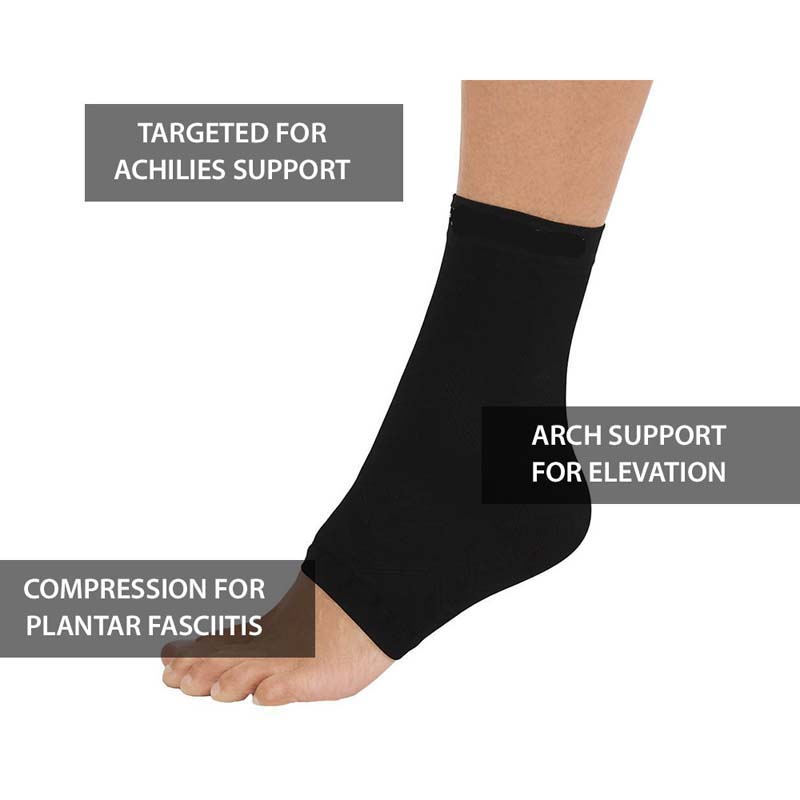From Diagnosis to Recoveryc- Navigating Plantar Fasciitis

Featured Products for Plantar Fasciitis Foot Pain Relief
Plantar fasciitis, a common cause of heel pain, can be a challenging condition that affects daily activities and mobility. Navigating the journey from diagnosis to recovery involves understanding the causes, implementing effective treatments, and making lifestyle adjustments. In this comprehensive guide, well walk through the various stages of plantar fasciitis, offering insights and strategies for each step of the way.
1. Understanding the Diagnosis:
-
Symptoms: Plantar fasciitis often presents with sharp pain in the heel or along the bottom of the foot, particularly during the first steps in the morning or after periods of rest. The pain may gradually improve with activity but can return after prolonged standing or intense physical activity.
-
Professional Evaluation: If you suspect plantar fasciitis, seek a professional evaluation from a healthcare provider or a podiatrist. They will perform a physical examination, discuss your symptoms and medical history, and may order imaging tests, such as X-rays, to confirm the diagnosis.
2. Developing a Treatment Plan:
-
Rest and Activity Modification: The initial phase of treatment often involves rest and activity modification. Avoid high-impact activities that worsen symptoms and incorporate periods of rest to allow the plantar fascia to heal.
-
Icing: Applying ice to the affected heel can help reduce inflammation. Use a cloth or towel to protect the skin and apply ice for 10-15 minutes at a time.
-
Stretching Exercises: Gentle stretching exercises for the calf muscles and the plantar fascia can improve flexibility and alleviate tension. Regular stretching, including toe curls and ankle circles, is essential.
-
Footwear Considerations: Wear supportive footwear with proper arch support. Avoid shoes with inadequate support or excessive wear.
-
Orthotic Inserts: Depending on the severity of the condition, orthotic inserts or custom-made insoles may be recommended to provide additional support and alignment.
-
Anti-Inflammatory Medications: Nonsteroidal anti-inflammatory drugs (NSAIDs) may be recommended to manage pain and reduce inflammation. Consult with a healthcare professional before using medication.
3. Rehabilitation and Physical Therapy:
-
Professional Guidance: A physical therapist can provide targeted exercises and techniques to strengthen the muscles of the foot and lower leg, improve biomechanics, and enhance overall foot function.
-
Stretching Programs: A physical therapist may develop a customized stretching program to address specific muscle imbalances and promote optimal flexibility.
-
Strengthening Exercises: Exercises that target the muscles of the foot, ankle, and calf can contribute to better support for the plantar fascia.
4. Long-Term Management and Lifestyle Adjustments:
-
Weight Management: Maintaining a healthy weight is crucial for reducing excess stress on the feet. Adopting a balanced diet and engaging in regular physical activity support overall foot health.
-
Appropriate Footwear: Continuously wear supportive footwear, even after symptoms have improved. Consider consulting with a podiatrist for advice on the most suitable footwear for your foot type.
-
Regular Stretching Routine: Incorporate a consistent stretching routine into your daily activities, even after symptoms have resolved, to prevent the recurrence of plantar fasciitis.
-
Orthotic Maintenance: If prescribed orthotic inserts, continue to use them as recommended by your healthcare provider to maintain proper foot alignment and support.
5. Seeking Professional Advice for Persistent Symptoms:
-
If symptoms persist or worsen despite conservative measures, consult with your healthcare provider or a podiatrist for a reevaluation. They may recommend additional interventions, such as corticosteroid injections or other advanced treatments.
-
In rare cases where conservative measures do not provide relief, surgical options may be considered. Consultation with a podiatric surgeon can provide insights into the potential benefits and risks of surgical intervention.
Conclusion:
Navigating plantar fasciitis involves a comprehensive approach that includes understanding the diagnosis, implementing effective treatments, and making long-term lifestyle adjustments. By seeking professional guidance, staying consistent with prescribed treatments, and adopting preventive measures, individuals can effectively manage plantar fasciitis and promote optimal foot health. Remember that each persons journey is unique, and the key is to tailor the treatment plan to individual needs and responses.
Featured Products for Plantar Fasciitis Foot Pain Relief
Latest Blogs
- Taking a Stand Against Heel Pain: Practical Solutions
- Happy Heels, Happy Life: Banishing Foot Pain for Good
- The Road to Relief: Strategies for Combating Heel Pain
- Heel to Toe Wellness: Tackling Foot Pain Head-On
- Foot Pain Decoded: Understanding the Signals Your Feet Send
- Soothing Steps: Natural Remedies for Heel and Foot Pain
- Putting Your Best Foot Forward: Managing Heel Discomfort
- The ABCs of Happy Feet: Beating Heel and Foot Pain
- From Heel to Toe: Navigating Common Foot Pain Issues
- Taking a Step Back: Causes and Remedies for Heel Pain
- Footloose and Pain-Free: Tips for Happy Heels and Feet
- Soleful Solutions: A Guide to Alleviating Heel and Foot Discomfort
- Stepping Into Comfort: Understanding Heel and Foot Pain
- From Pain to Progress: Inspiring Plantar Fasciitis Journeys
- Living a Full Life with Plantar Fasciitis: Success Stories
- Plantar Fasciitis and Exercise: Finding the Right Balance
- The Impact of Stress on Plantar Fasciitis Symptoms
- Plantar Fasciitis: When to Seek Professional Help
- Inflammatory Foods and Plantar Fasciitis: What to Avoid
- Ergonomics and Plantar Fasciitis: A Comprehensive Guide
- The Importance of Rest in Plantar Fasciitis Recovery
- Traveling with Plantar Fasciitis: Tips for Happy Feet
- Plantar Fasciitis and Your Sleep: Improving Rest Quality
- The Psychological Aspect of Living with Plantar Fasciitis
- Plantar Fasciitis and High-Impact Activities: Navigating Risks
- How to Stay Active with Plantar Fasciitis: Practical Tips
- Plantar Fasciitis and Aging: Strategies for Seniors
- Cryotherapy for Plantar Fasciitis: Icy Relief for Your Feet
- Aquatic Exercise for Plantar Fasciitis: Dive into Healing
- Mindfulness and Meditation for Plantar Fasciitis Relief
- Heel Pain 101: A Guide to Plantar Fasciitis
- Finding Relief - Plantar Fasciitis Home Remedies
- The Emotional Toll of Chronic Plantar Fasciitis
- Post-Workout Foot Care for Plantar Fasciitis Sufferers
- DIY Foot Massage Techniques for Plantar Fasciitis
- From Diagnosis to Recoveryc- Navigating Plantar Fasciitis
- Plantar Fasciitis in Children Signs and Solutions
- Plantar Fasciitis and Weight: Impact on Foot Health
- How Nutrition Affects Plantar Fasciitis Recovery
- Yoga for Plantar Fasciitis: Poses for Pain Relief
- Breaking Down Plantar Fasciitis Myths and Misconceptions
- Plantar Fasciitis Stretches - Daily Routine for Relief
- The Link Between Plantar Fasciitis and Flat Feet
- Plantar Fasciitis in Pregnancy - What to Expect
- Desk Job Dilemma - Coping with Plantar Fasciitis at Work
- Plantar Fasciitis in Athletes Strategies for Recovery
- Massage and Plantar Fasciitis A Soothing Combination
- Plantar Fasciitis at Night: Tips for Better Sleep
- Plantar Fasciitis vs Heel Spurs - Understanding the Difference
- The Role of Stretching in Plantar Fasciitis Recovery
- Running with Plantar Fasciitis: Dos and Donts
- Preventing Plantar Fasciitis: Tips for Foot Health
- Natural Remedies for Plantar Fasciitis You Havent Tried
- Heel Pain Demystified: Plantar Fasciitis Explained
- Best Shoes for Plantar Fasciitis: A Comprehensive Guide
- Managing Plantar Fasciitis Pain: Tips and Tricks
- The Complete Guide to Plantar Fasciitis Treatment Options
- 10 Effective Exercises for Plantar Fasciitis Relief at Home
- Understanding Plantar Fasciitis: Causes and Symptoms
- Why do I get Pain in My Feet at Night
- Is pain in your feet a sign of diabetes
- What causes pain in my feet
- Plantar Fasciitis - Why so Painful
- What is that pain in my heel
- Should I Walk with Foot Pain
- How to Treat Ankle Pain
- 10 Best Exercises of Plantar Fasciitis
- Do Compression Socks Help Foot Pain
- Do Insoles Work for Foot Pain
- Best Stretches for Plantar Fasciitis
- 5 Causes of Plantar Fasciitis
- Do Back Posture Braces Actually Work
- Foot pain from walking
- Best Insoles for Plantar Fasciitis
- Pain in heel of foot after Running
- Treatment for Pain in arch of foot
- Pain on top of foot
- Mortons neuroma treatment
- How to remove an Ingrown Toenail
- Foot Heel Spur Pain
- Sore Foot in the Morning
- Suffer Heel Pain in the Morning ?
- Start a running routine
- Running through Fatigue
- Best Achilles Tendonitis and Ankle Excercises
- Causes of Achilles Tendonitis and Ankle Pain
- Plantar Fasciitis Cure and Treatment
- Best Plantar Fasciitis Products
- Causes of Plantar Fasciitis and Heel Spur Pain
- Best Plantar Fasciitis Excercises



















